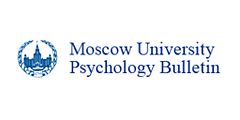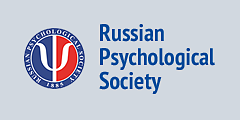
Lomonosov Moscow State University
Moscow, Russia
-
Prerequisites of Sociality: Historical and Evolutionary Analysis
-
Background. Discussion of the social origins of personality formation, based on the biological individual, is a characteristic feature of modern interdisciplinary researches at the junction of natural science and the humanities. At the same time, evolutionary aspects of the relationship between the biological (innate) and the social (acquired) — i.e., the problem of the origin of sociality — come to the forefront.
Objective. This article presents and discusses the hypothesis that the evolutionary origins of sociality are processes of evolutionary divergence (increasing individual diversity) and convergence (symbiosis) that define two oppositely directed vectors of the development of life from its simplest forms.
Method and Results. The theoretical and experimental data used to discuss the hypothesis are considered here from the standpoint of the historical evolutionary approach to the processes of formation (evolution) of the uniqueness of the personality and of social interpersonal relations. The approach is based on an understanding of these processes as a special case of the evolution of interacting systems on the basis of two opposing trends — towards preserving and towards changing the system. The hypothesis allows us to answer two questions about the ambivalence of human existence in society: (a) Why do all people, regardless of their social status, find it so difficult to endure loneliness, which is incompatible with both the mental and even physical health of each of us? (b) Why at the same time do all of us involuntarily protect the “boundaries” of our own physical, mental, and social “Me”, the violation of which is as destructive (unacceptable) to us as is loneliness?
Conclusion. Systematic historical-evolutionary analysis of the sciences of nature, society, and humankind allows us to isolate general patterns of development of complex systems, leading to a more accurate understanding of the phenomenon of personality. Such an interdisciplinary approach was used in this work on the biological roots of sociality and the particular features of individual existence in the external and to some extent social environment that generates unique individuals.
DOI: 10.11621/pir.2018.0301
Keywords: systems, social communities, evolution of societies, sociality, symbiosis, indi- vidual diversity, person, historical and evolutionary approach
-
-
Psychophysiological indicators of the human functional state in the process of socio-psychological testing ethnic and religious attitudes
-
Background. To assess the structure of inter-ethnic attitudes and the risks of ethnoreligious tension, psychologists mostly use questionnaires, interviews, subjective scaling, content analysis, and special tests. One possible approach to increasing the validity and reliability of these explicit methods is the use of the registration of psychophysiological indicators while a recipient completes the questionnaire or test forms.
Objective. The results of a pilot psychophysiological research are presented, which focus on the study of human psycho-emotional states during socio-psychological testing to identify attitudes in the field of interethnic and interfaith relations.
Design. The essence of the applied experimental approach is to control the functional (psycho-emotional) state of a respondent using the registration of complex psychophysiological (physiological and behavioral) responses in the process of completing the socio-psychological questionnaire.
Results. It was shown that the rhythmic brain activity (ratio of the power indexes of alpha and beta rhythms), the amplitude of the systolic wave (photoplethysmogram) (ASW PhPG) and the magnitude (length) of the ‘circumflex line of the Galvanic Skin Response’ (GSR-L) may be the complex of indicators that possess sufficiently high selective sensitivity to differentiate nonspecific reactions of the human nervous system to personally important (emotiogenic, stressful) questions in the questionnaire.
Conclusion. The proposed approach may help to identify stressful (emotiogenic) issues (questions) in socio-psychological tests and questionnaires that are of the greatest interest to the subject and, as a result, most adequately reflect individual and population attitudes in the field of social relations.
DOI: 10.11621/pir.2018.0101
Keywords: socio-psychological testing, ethnic and religious attitudes, psycho-emotional states, psychophysiological diagnostics
-
-
Face cognition in humans: Psychophysiological, developmental, and cross-cultural aspects
-
Investigators are finding increasing evidence for cross-cultural specificity in face cognition along with individual characteristics. The functions on which face cognition is based not only are types of general cognitive functions (perception, memory) but are elements of specific mental processes. Face perception, memorization, correct recognition of faces, and understanding the information that faces provide are essential skills for humans as a social species and can be considered as facets of social (cultural) intelligence. Face cognition is a difficult, multifaceted set of processes. The systems and processes involved in perceiving and recognizing faces are captured by several models focusing on the pertinent functions or including the presumably underlying neuroanatomical substrates. Thus, the study of face-cognition mechanisms is a cross-disciplinary topic. In Russia, Germany, and China there are plans to organize an interdisciplinary crosscultural study of face cognition. The first step of this scientific interaction is conducting psychological and psychophysiological studies of face cognition in multinational Russia within the frame of a grant supported by the Russian Science Foundation and devoted to “cross-cultural tolerance”. For that reason and in the presence of the huge diversity of data concerning face cognition, we suggest for discussion, specifically within the psychological scientific community, three aspects of face cognition: (1) psychophysiological (quantitative data), (2) developmental (qualitative data from developmental psychology), and (3) cross-cultural (qualitative data from cross-cultural studies). These three aspects reflect the different levels of investigations and constitute a comprehensive, multilateral approach to the problem. Unfortunately, as a rule, neuropsychological and psychological investigations are carried out independently of each other. However, for the purposes of our overview here, we assume that the main factors that could influence the developmental, individual psychophysiological, and cross-cultural differences in face cognition are not only biological but also social and cultural. One of the principal tasks of this article is to draw the attention of psychologists to the physiology of face processing and to draw the attention of neuroscientists to the psychology of face cognition. Thus, the main goal of the article is to instigate a discussion among social psychologists, psychophysiologists, and neuroscientists about the mechanisms of face cognition, which, as in a mirror, reflect the basic, fundamental “psychophysical” problem of psychophysiology.
DOI: 10.11621/pir.2016.0404
Keywords: face cognition, social psychophysiology, development, other-ethnicity effects, brain mechanisms
-
-
Psychophysiological methods for the diagnostics of human functional states: New approaches and perspectivesChernorizov, Alexsander M.; Isaychev, S.A.; Zinchenko, Yu. P. ; Galatenko, V.V.; Znamenskaya, I.A.; Zakharov, P.N.; Khakhalin, A.V.; Gradoboeva, O.N.PDF HTML18439“ CITE
Chernorizov A. M., Isaychev S. A., Zinchenko Yu. P., Znamenskaya I. A., Zakharov P. N., Khakhalin A. V., Gradoboeva O. N., Galatenko V. V. (2016). Psychophysiological methods for the diagnostics of human functional states: New approaches and perspectives. Psychology in Russia: State of the Art, 9(4), 23-36.
copied
-
L. S. Vygotsky in his famous methodological essay “The historical meaning of psychological crisis” (1928) emphasized the importance of studying any psychological process or state as a “whole” — that is, as characterized from the subjective and objective sides at the same time. This position is fully relevant for studying the human functional states (FSes). Today the objective psychophysiological diagnostics of human FSes in activities associated with a high risk of technological disasters (in nuclear-power plants, transportation, the chemical industry) are extremely relevant and socially important. This article reviews some new psychophysiological methods of FS assessment that are being developed in Russia and abroad and discusses different aspects of developing integral psychophysiological FS assessment. The emphasis is on distant methods of FS diagnostics: the bioradiolocation method, laser Doppler vibrometry, eye tracking, audio and video recordings, infrared thermography. The possibilities and limitations of the most popular emotion atlases — the Facial Affect Scoring Technique (FAST) and the Facial Action Coding System (FACS) — in developing distant visual-range and infrared-range systems for automated classification of facial expressions are analyzed. A special section of the article concentrates on the problem of constructing an integral psychophysiological FS index. Mathematical algorithms that provide a partition of FS indicators into different FS types are based on various methods of machine learning. We propose the vector approach for construction of complex estimations of the human FSes.
DOI: 10.11621/pir.2016.0403
Keywords: functional states, distant diagnostics, integral estimating, vector approach
-
-
Eye movement parameters while reading show cognitive processes of structural analysis of written speech
-
This paper gives an overview of the published data on eye movement parameters while reading sentences in different languages with both local and global syntactic ambiguity. A locally ambiguous sentence contains a syntactically problematic phrase that leads to only one interpretation, while a globally ambiguous sentence has more than one distinct interpretation. In the first case the ambiguity persists only to the end of the sentence, when it is successfully resolved; in the second case the ambiguity is still present after reading the whole sentence. The obvious difficulty in analyzing the structure of locally and globally ambiguous sentences leads to increased reading time compared with unambiguous sentences. The syntactic ambiguity increases two major parameters: the fixation duration when reading words critical for interpreting the sentence, and the frequency of regressive saccades to reread those words. The reading time for critical words, disambiguating the local ambiguity, depends on the principle of early/late closure (i.e., high/low attachment): preferring a recurrent pattern to associate the critical word with a distant or closer word, respectively (as determined by its position in the sentence), and differs across languages. The first study of eye movement parameters in reading globally syntactic ambiguous sentences in the Russian language is reported in this paper. Our findings open up the prospects of quantitative studies of syntactic disambiguation in Slavonic and Romano-Germanic languages.
DOI: 10.11621/pir.2016.0210
Keywords: reading, psycholinguistics, syntactic ambiguity, gaze fixations, regressive saccades, review
-
-
From physiological psychology to psychological physiology: Postnonclassical approach to ethnocultural phenomena
-
In modern science, along with the “classic” and “non-classical” approach to solving fundamental and applied problems, there is an actively developing “postnonclassical” research paradigm. This renovation of general scientific methodology has been accompanied by the emergence of new experimental technologies and new scientific research directions based on them. “Social psychophysiology” is one such direction. It is formed within the frame of postnonclassical methodology at the intersection of neuroscience and psychology. This work is devoted to the analytical review of the methods, achievements and prospects of contemporary social neuroscience and social psychophysiology studying brain structures that are specifically related to the implementation of social forms of behavior and intercultural communication. Physiological studies of brain activity during social interaction processes, which are simulated using virtual reality environments, are analyzed, and the physiological approach to the study of the brain mechanisms associated with social perception, social cognition and social behavior is used. Along with the analysis of psychophysiological studies of the mechanisms of social perception and social cognition, we discuss the theories of “Brain Reading” and “Theory of Mind” and the underlying data concerning “Gnostic neurons recognition of persons and recognition of emotional facial expressions”, “mirror neurons”, “emotional resonance” and “cognitive resonance”. Particular emphasis is placed on the discussion of a fundamentally new trend in the study of the relationship between the brain and culture (i.e., “cultural neuroscience”). Related to this connection, the following topics are raised: physiological mechanisms protecting the “individual distance” in communication between members of a personified community, psychophysiological approaches to the study of cross-cultural differences, physiological mechanisms of social classification (particularly the formation of attitudes toward representatives of various social groups and toward the content of socially oriented information), and psychophysiological approaches to the study of processes of social classification in the field of intercultural relations (racial perception, stereotypes and prejudices).
DOI: 10.11621/pir.2015.0401
Keywords: postnonclassical approach, psychological physiology, cultural neuroscience, virtual reality, brain activity, ethnocultural identity, intercultural and interethnic attitudes, cross-cultural differences
-
-
Automated real-time classification of functional states: the significance of individual tuning stageGalatenko, V.V.; Livshitz, E.D.; Chernorizov, Alexsander M.; Zinchenko, Yu. P. ; Galatenko, A.V.; Staroverov, V.M.; Isaychev, S.A.; Lebedev, V.V.; Menshikova, G.Ya.; Sadovnichy, V.A.; Gusev, A.N.; Gabidullina, R.F.; Podol’skii, V.E.PDF HTML18831“ CITE
Vladimir V. Galatenko, Evgeniy D. Livshitz, Alexander M. Chernorizov, Yury P. Zinchenko, Alexey V. Galatenko, Vladimir M. Staroverov, Sergey A. Isaychev, Vyacheslav V. Lebedev, Galina Ya. Menshikova, Alexey N. Gusev, Ekaterina M. Lobacheva, Rozaliya F. Gabidullina, Vladimir E. Podol’skii, Victor A. Sadovnichy (2013). Automated real-time classification of functional states: the significance of individual tuning stage. Psychology in Russia: State of the Art, 6(3), 40-47
copied
-
Automated classification of a human functional state is an important problem, with applications including stress resistance evaluation, supervision over operators of critical infrastructure, teaching and phobia therapy. Such classification is particularly efficient in systems for teaching and phobia therapy that include a virtual reality module, and provide the capability for dynamic adjustment of task complexity.
In this paper, a method for automated real-time binary classification of human functional states (calm wakefulness vs. stress) based on discrete wavelet transform of EEG data is considered. It is shown that an individual tuning stage of the classification algorithm — a stage that allows the involvement of certain information on individual peculiarities in the classification, using very short individual learning samples, significantly increases classification reliability. The experimental study that proved this assertion was based on a specialized scenario in which individuals solved the task of detecting objects with given properties in a dynamic set of flying objects.
DOI: 10.11621/pir.2013.0304
Keywords: human functional state, EEG data, automated classification, individual tuning, stress.
-
-
Unasked questions and unused answers in psychologyPöppel, Ernst; Bao, Ya.; Shihui Han; Ushakov, Dmitry V.; Kovalev, A.I.; Chernorizov, Alexsander M.; Menshikova, G.Ya.; Zaytseva, Yu.S.; Zabotkina, V.I.; Sozinov, A.A.; Gutyrchik, E.PDF HTML25539“ CITE
Pöppel E., Bao Ya., Shihui Han, Sozinov A. A., Ushakov D. V., Kovalev A. I., Chernorizov A. M., Menshikova G. Ya., Zinchenko Yu. P., Zabotkina V. I., Gutyrchik E., Zaytseva Yu. S.. (2013). Unasked questions and unused answers in psychology. Psychology in Russia: State of the Art, 6(3), 4-17
copied
-
Contemporary psychology and cognitive neuroscience create many opportunities for studying the brain functions, but also generate numerous challenges. To date, scientists face common conceptual problems which are relevant to almost every research study/ case such as: classification of functions, unified methodological approaches, explanation of the psychological phenomenon etc. The Sino-German Workshop which took place in Hamburg in 2013 aimed to address unasked questions and unused answers, attracting scientists from different countries and different fields of psychology, neuroscience, medicine, history, and philosophy. The present discussion on the 9 unasked questions was initiated by Professor Ernst Poeppel and was held on by Russian participants from various academic institutions.
DOI: 10.11621/pir.2013.0301
Keywords: contemporary psychology, cognitive neuroscience, 10th Sino-German Workshop Selected Papers
-
-
The Psychophysiological Diagnostics of the Functional State of the Athlete. Preliminary DataIsaychev, S.A.; Chernorizov, Alexsander M.; Korolev, A.D.; Isaychev, E.S.; Dubynin, I.A.; Zakharov, I.M.
-
The original experimental scheme was developed to investigate athletes’ functional states (FS) dynamics. The procedure allowed modeling various FS important for predicting the professional success of athletes: psychological and physiological stress, fatigue, and optimal FS (OFS). There were two main criteria for differentiation of the FS under study: efficiency rates and the psychological and physiological costs of the achieved efficiency level. Analysis of the FS-dependent psychophysiological changes showed significant interindividual differences on a number of parameters. Thus, no single indicator could be used as effective diagnostics for the FS criteria. A minimum number of indicators need to be recorded included cardiovascular indicators (heart rate, ECG), respiration, muscle tension (EMG), and brain activity (EEG) in the range of alpha and beta waves. The main problem can be artifacts induced by movement and muscle tension. The special procedure for artifact rejection and reduction of the artifacts was developed. It allowed recording EEG, ECG, and EOG signals simultaneously. Another problem was related to the development of the mathematical algorithm to analyze individual data and differentiate patterns of the signals recorded from the athletes. An original approach to differentiate the FS – the k-means clustering algorithm – was offered based on seven psychophysiological indicators. Results of clustering showed that the k- means algorithm for seven-component vectors allows one with confidence to differentiate state of quiet wakefulness, states of psychological and physiological stress. As the number of parameters used is attenuated from seven to four (without the EEG parameters) the accuracy of distinguishing FS is significantly reduced. To construct a complete and accurate differentiation of an athlete’s FS one should collect some statistical data on the dynamics of each FS in different time periods of the person’s life – in the process of training, after successful competition, and after losing competition.
DOI: 10.11621/pir.2012.0015
Keywords: sportsperson, functional state, psychophysiological indicators, integral evaluation.
-
-
Event-Related Potentials in Deception Detection
-
The problem of lie detection has a long history. Main achievements in this field are concerned with registration of peripheral nervous system indicators. Our experiment provides possibility for development of a new lie detection technology, based on neurophysiologic correlates of cognitive processes diagnostics that underlie deception. The experiments were conducted by “Audio-Visual Slider” software (by Medicom MTD), which performed synchronized stimuli presentation and electrophysiological recording.
DOI: 10.11621/pir.2011.0029
Keywords: lie detection, nervous system, electroencephalogram, psychophysiology.
-
-
Modular Organization of Mechanisms of Achromatic Vision in Human and Animals
-
Psychophysiological research into achromatic vision in humans and vertebrates displays that light intensity is coded by a two-dimensional “excitation vector”. The components of that vector are responses of brightness and darkness neurons (or, according to another classification, on- and off -neurons). It means that a current sensation of brightness is determined by a corresponding interrelation between activities of those two systems responding in opponent way to light onset and off set. The present research is devoted to testing of a hypothesis asserting that two-module organization of achromatic vision is a universal principle of brightness coding in a wide raw of animals including invertebrates. The paper represents certain results of registration and analysis of electroretinogram and total activity of the optical nerve in snail Helix lucorum to diffuse light fl ashes of different intensities. The obtained experimental data, along with the already existing reference data, allow us to assume that on- and off -systems may constitute the neural basis for brightness coding in the invertebrates. The peculiarity of on- and off -systems in vertebrates is that they are formed already at the photoreceptor level.
DOI: 10.11621/pir.2011.0028
Keywords: achromatic vision, invertebrates, sensations of brightness, electroretinogram, optical nerve, on- and off -systems in vision, “brightness” and “darkness” neuronal modules.
-
-
Technologies of Virtual Reality in Psychology of Sports of Great Advance: Theory, Practice and Perspectives
-
The article is devoted to the problem of using a new experimental technology of “virtual reality” (VR) in psychological research. Methods of virtual reality actively become embedded in tooling of up-to-date experimental psychology. Next in turn there is a task of embedding of VR technologies in various areas of applied psychology like sport psychology. Application of modern computer methods discovers new perspectives for sport psychology.
DOI: 10.11621/pir.2011.0008
Keywords: virtual reality, experimental technology, computer methods, sports psychology, psychophysiology
-
-
A Geometrical Approach to Research into Signal Recognition in Visual Systems of Humans and Animals
-
In the paper an attempt is made to justify the importance of geometrical language (especially metric space models) for the description of visual perception processing. The tradition to use geometry for the description of psychophysiological processes goes back to a Newtonian color circle. At present there are many examples of such models, as well as of examples from other areas of mathematics. However, we want to justify a position, that geometrical language is not simply one of formal languages used for the description of visual perception phenomena. We'll try to represent it as the approach, which includes both the formal description of psychological phenomena and neurophysiological mechanisms, as well as experimental techniques of research into these phenomena and mechanisms.
DOI: 10.11621/pir.2010.0016
Keywords: vector psychophysiology, categoriality of perception, perception of form and color, large (suprathreshold) interstimuli differences, multidimensional scaling, geometrical modeling of subjective perceptual spaces, spherical model of visual perception, neural modules (ensembles)
-
-
Technologies of Virtual Reality in the Context of WorldWide and Russian Psychology: Methodology, Comparison with Traditional Methods, Achievements and PerspectievesZinchenko, Yu. P. ; Chernorizov, Alexsander M.; Menshikova, G.Ya.; Bayakovsky, Yu. M.; Voiskounsky, A.E.PDF HTML42667“ CITE
Zinchenko, Yu.P., Menshikova, G.Ya., Bayakovsky, Yu.M., Chernorizov, A.M., Voiskounsky, A.E. (2010). Technologies of Virtual Reality in the Context of WorldWide and Russian Psychology: Methodology, Comparison with Traditional Methods, Achievements and Perspectives. Psychology in Russia: State of the Art, 3, 12-45.
copied
-
The paper introduces virtual reality systems as a new methodolology of carrying out both traditional and originally designed experimental studies in psychology and in a broader context - in neuroscience. This methodology, often differing from classical approaches toward planning and performing a study in cognitive, social, educational, organizational and numerous other disciplines within psychology, is placed in the context of genuine Russian and at the same time of world-wide psychological theories, conceptions and traditions. Advantages, currently available results, challenges and perspectives of the virtual paradigm in experimental psychology, psychotherapy and psychological rehabilitation are thoroughly described and analyzed. The ideas of immersive virtuality are also shown to play a profound role at diverse levels of innovative learning and teaching, including special, extracurricular, and college education. Besides, applied virtual reality systems are presented as being of serious importance for the university students' training: it is expected that new generations of professional psychologists will use these systems extensively. The multifaceted theoretical activities and applied work of the staff and students affiliated with the Psychology Department, Lomonosov Moscow State University, aimed at development and usage of immersive virtual reality systems are fully presented in the paper.
DOI: 10.11621/pir.2010.0001
Keywords: experimental psychology, neuroscience, psychotherapy, psychological rehabilitation, methodology, virtual reality, immersion, modality, innovative education, motor activity, psychophysics, cognitive psychology
-
-
Vector Encoding of Light Intensity in Neural Networks of Visual System
-
Intracellular research of land snail Helix lucorum L. eye demonstrates two types of visual cells responding to flashes of white light by slow sustained depolarization (D-type) and by slow sustained hyperpolarization (H-type), respectively. Peaks of spectral sensitivity of both cell types at 465-500 nm coincide with peak of spectral sensitivity of photopigment "rhodopsin". The two-channel vector model of achromatic vision of snail is proposed. According to the model, responses of D- and H-cells constitute two-dimensional 'excitation vector' of constant length, the direction of which is the code of light intensity. The two-dimensional vector model of light encoding in snails' eye is analogous with achromatic vision models of achromatic vision in vertebrates based on psychophysical and neurophysiological data in fish, rabbit, monkey and human. So, intracellular data in snail taken together with data on vertebrate animals testify in favor of the hypothesis that 2-dimensioanl module of "bright" and "dark" cells is the universal opponent mechanism of "vector encoding" of light intensity in neuronal nets for vision.
DOI: 10.11621/pir.2008.0020
Keywords: psychophysiology, methodology
-
-
Diagnosing Human Psychoemotional States by Combining Psychological and Psychophysiological Methods with Measurements of Infrared and THz Radiation from Face AreasBerlovskaya, E.E.; Isaychev, S.A.; Chernorizov, Alexsander M.; Ozheredov, I.A.; Adamovich, T.V.; Isaychev, E.S.; Cherkasova, O.P.; Makurenkov, A.M.; Shkurinov, A.P.; Varaksin, A.N.; Gatilov, S.B.; Kurenkov, N.I.; Manaenkov, A.E.PDF HTML5476“ CITE
Berlovskaya, E.E.,Isaуchev, S.A., Chernorizov, A.M., Ozheredov, I.A., Adamovich, T.V., Isaуchev, E.S., … Manaenkov, A.E. (2020). Diagnosing Human Psychoemotional States by Combining Psychological and Psychophysiological Methods with Measurements of Infrared and THz Radiation from Face Areas. Psychology in Russia: State of the Art, 13(2), 64-83
copied
-
Background. One promising direction in development of contactless techniques for assessment of the human psychoemotional state (PES) is elucidation of the relationships between psychophysiological indices and electromagnetic radiation in the IR and THz ranges.
Objective. To present a complex approach to assessing PESs based on combining psychological testing and psychophysiological diagnostics with measurements of radiation in the IR-THz range from face areas.
Methods. Stressful psychoemotional states were provoked by physical or cognitive stressors. The PES was monitored by psychological testing and registration of heart rate, photoplethysmogram, galvanic skin response, and respiration rate. The facial images in the IR-THz range were extracted by an IR/V-T0831Cdetector (NEC, Japan).
Results and Discussion. Different PESs are characterized by different specific patterns of psychophysiological parameters. Scores on the anxiety test are highly correlated with scores on the chronic stress questionnaire, but there are no reliable links between the data of psychological tests and the psychophysiological indicators. This discrepancy allows us to assume that for reliable identification of PESs, it is necessary to combine these technologies into one diagnostic complex. We found statistically significant correlations between the intensity of the IR-THz image in the forehead and the galvanic skin response.
Conclusion. For the effective diagnosis and forecast of changes in the PES, it is important to consider both the psychological and physiological data. Despite the relatively low signal-to-noise ratio and low frequency of image recording, it is possible to extract informative THz parameters of the broadband IR-THz signal and associate them with psychophysiological reactions. The improvement of IR-THz detectors and the development of new processing methods will allow wide use of the THz range for remote assessment of human PESs in real time.
DOI: 10.11621/pir.2020.0205
Keywords: psychoemotional (stressful) states; psychophysiological diagnosis; psychological testing; instrumental contactless psychodiagnostics; infrared radiation; terahertz waves
-









